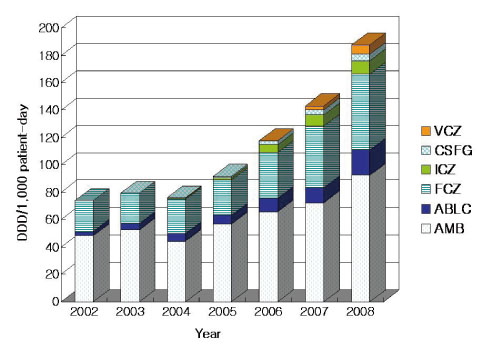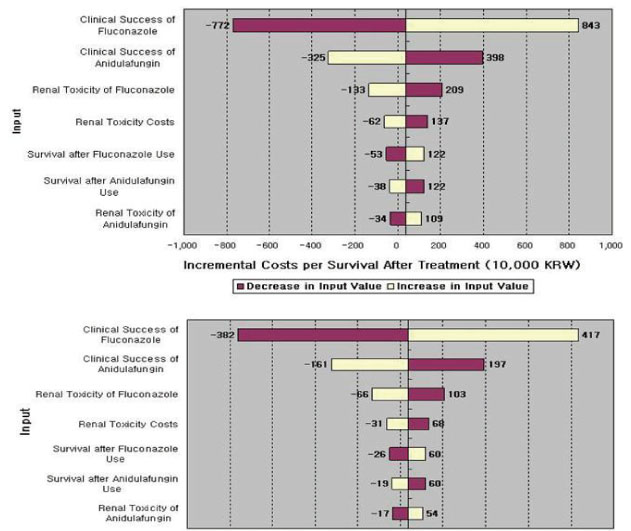Infect Chemother.
2010 Aug;42(4):209-215. 10.3947/ic.2010.42.4.209.
Current Usage and Prospect of New Antifungal agents in Korea
- Affiliations
-
- 1Division of Infectious Disease, Department of Internal Medicine, College of Medicine, The Catholic University of Korea, Seoul, Korea. infect@catholic.ac.kr
- KMID: 1457380
- DOI: http://doi.org/10.3947/ic.2010.42.4.209
Abstract
- The incidence of invasive fungal infections has been increased worldwide along with the increasing population at high risk for fungal infection. However, no data is available for the current status of usage of antifungal agents in Korea. We described the usage of antifungal agents including second-generation triazole and echinocandins that have been recently introduced. Data from Health Insurance Review and Assessment Service were analyzed. Estimated total DDDs (daily defined doses)/1,000 patient-day of parenteral antifungal agents were 187.6 in 2008 and 143.2 in 2007 and annual rates of increase was 20% to 30% since 2004. Indeed, increased percentage of newer agents were observed. Changes of the treatment guidelines and the regulations for insurance coverage are considered to influence the trend of antifungal usage.
Keyword
MeSH Terms
Figure
Cited by 1 articles
-
The Changing Patterns of Antibiotics Usage in Korea during 1981-2008
Youn Jeong Kim, Hyun Ji Chun, Jung Woo Lee, Kyung-Wook Hong, Sang Il Kim, Seong Heon Wie, Yang Ree Kim, Moon Won Kang
Infect Chemother. 2012;44(6):411-418. doi: 10.3947/ic.2012.44.6.411.
Reference
-
1. Kang MW. Triazole antifungal drugs. Korean J Infect Dis. 1990. 22:1–4.2. Woo JH, Chung DR, Ryu J. Systemic antifungal agents. Korean J Med Mycol. 1997. 2:110–122.3. Herbrecht R, Denning DW, Patterson TF, Bennett JE, Greene RE, Oestmann JW, Kern WV, Marr KA, Ribaud P, Lortholary O, Sylvester R, Rubin RH, Wingard JR, Stark P, Durand C, Caillot D, Thiel E, Chandrasekar PH, Hodges MR, Schlamm HT, Troke PF, de Pauw B. Invasive Fungal Infections Group of the European Organisation for Research and Treatment of Cancer and the Global Aspergillus Study Group. Voriconazole versus amphotericin B for primary therapy of invasive aspergillosis. N Engl J Med. 2002. 347:408–415.
Article4. Walsh TJ, Teppler H, Donowitz GR, Maertens JA, Baden LR, Dmoszynska A, Cornely OA, Bourque MR, Lupinacci RJ, Sable CA, de Pauw BE. Caspofungin versus liposomal amphotericin B for empirical antifungal therapy in patients with persistent fever and neutropenia. N Engl J Med. 2004. 351:1391–1402.
Article5. van Burik JA, Ratanatharathorn V, Stepan DE, Miller CB, Lipton JH, Vesole DH, Bunin N, Wall DA, Hiemenz JW, Satoi Y, Lee JM, Walsh TJ. National Institute of Allergy and Infectious Diseases Mycoses Study Group. Micafungin versus fluconazole for prophylaxis against invasive fungal infections during neutropenia in patients undergoing hematopoietic stem cell transplantation. Clin Infect Dis. 2004. 39:1407–1416.
Article6. Merlo J, Wessling A, Melander A. Comparison of dose standard units for drug utilisation studies. Eur J Clin Pharmacol. 1996. 50:27–30.
Article7. Cosentino M, Leoni O, Banfi F, Lecchini S, Frigo G. An approach for the estimation of drug prescribing using the defined daily dose methodology and drug dispensation data. Theoretical considerations and practical applications. Eur J Clin Pharmacol. 2000. 56:513–517.
Article8. Walsh TJ, Finberg RW, Arndt C, Hiemenz J, Schwartz C, Bodensteiner D, Pappas P, Seibel N, Greenberg RN, Dummer S, Schuster M, Holcenberg JS. National Institute of Allergy and Infectious Diseases Mycoses Study Group. Liposomal amphotericin B for empirical therapy in patients with persistent fever and neutropenia. N Engl J Med. 1999. 340:764–771.
Article9. Fischer T, Heussel G, Huber C. Liposomal amphotericin B for fever and neutropenia. N Engl J Med. 1999. 341:1152.
Article10. Prentice HG, Kibbler CC. Liposomal amphotericin B for fever and neutropenia. N Engl J Med. 1999. 341:1152–1153.
Article11. Rakita R. Liposomal amphotericin B for fever and neutropenia. N Engl J Med. 1999. 341:1153–1154.
Article12. Kontoyiannis DP, Lewis RE. Caspofungin versus liposomal amphotericin B for empirical therapy. N Engl J Med. 2005. 352:410–414.
Article13. Kim EC, Kim JS, Jung HJ. In vitro activity of antifungal agents against clinical isolates of yeasts. J Korean Soc Chemother. 1998. 16:215–220.14. Lee MK, Kim HR, Kang JO, Kim MN, Kim EC, Kim JS, Kim JJ, Park YJ, Song W, Shin JH, Lee KM, Lee NY, Lee M, Lee WG, Lee CK, Lee HJ, Chang CL, Choi TY. Susceptibility and trailing growth of Candida albicans to fluconazole: results of a Korean multicentre study. Mycoses. 2007. 50:148–149.
Article15. Lee JS, Shin JH, Lee K, Kim MN, Shin BM, Uh Y, Lee WG, Lee HS, Chang CL, Kim SH, Shin MG, Suh SP, Ryang DW. Species distribution and susceptibility to azole antifungals of Candida bloodstream isolates from eight university hospitals in Korea. Yonsei Med J. 2007. 48:779–786.
Article16. Kim SH, Shin JH, Kim EC, Lee K, Kim MN, Lee WG, Uh Y, Lee HS, Lee MK, Jeong SH, Jung SI, Park KH, Lee JS, Shin MG, Suh SP, Ryang DW. The relationship between antifungal usage and antifungal susceptibility in clinical isolates of Candida: a multicenter Korean study. Med Mycol. 2009. 47:296–304.
Article17. Blot S, Janssens R, Claeys G, Hoste E, Buyle F, De Waele JJ, Peleman R, Vogelaers D, Vandewoude K. Effect of fluconazole consumption on long-term trends in candidal ecology. J Antimicrob Chemother. 2006. 58:474–477.
Article18. Park JY, Shin JH, Uh Y, Kim EC, Kee SJ, Kim SH, Shin MG, Suh SP, Ryang DW. In vitro amphotericin B susceptibility of Korean bloodstream yeast isolates assessed by the CLSI broth microdilution method, Etest, and minimum fungicidal concentration test. Korean J Lab Med. 2008. 28:346–352.
Article19. Forrest GN, Weekes E, Johnson JK. Increasing incidence of Candida parapsilosis candidemia with caspofungin usage. J Infect. 2008. 56:126–129.
Article20. Moeremans K, Annemans L, Ryu JS, Choe KW, Shine WS. Economic evaluation of intravenous itraconazole for presumed systemic fungal infections in neutropenic patients in Korea. Int J Hematol. 2005. 82:251–258.
Article



